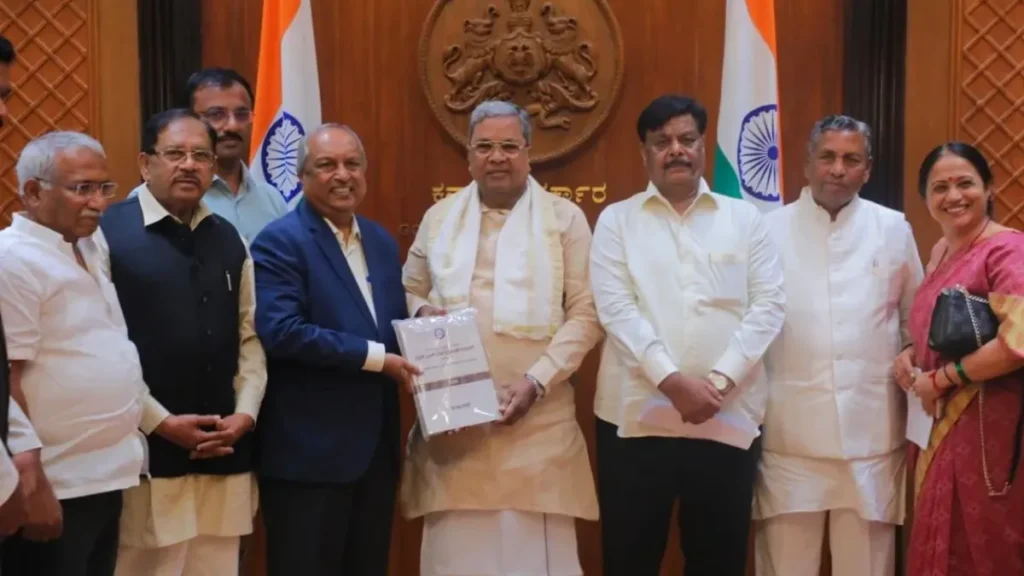The long-pending demand for internal reservation within Scheduled Castes sees momentum as the Justice Nagamohan Das Committee submits its detailed report to the Karnataka government. Cabinet discussions are imminent.
The demand for internal reservation within the Scheduled Caste (SC) community in Karnataka, echoed for decades, is finally showing signs of resolution. In a significant development, the Justice H N Nagamohan Das Commission has submitted a 1,765-page report to Chief Minister Siddaramaiah, recommending the reallocation of the existing 17% SC reservation quota among five newly created caste-based subgroups.
The move comes after a sustained campaign by marginalised SC subgroups, especially the Edagai communities, who have consistently alleged that the benefits of reservation are disproportionately cornered by dominant SC castes. Despite having 17% reservation, a large section within SCs has remained socially, economically, and educationally backward.
Also Read:Nagamohan Das commission submits its report on SC internal reservation to Karnataka Government
The Nagamohan Das Commission, constituted to study these discrepancies, conducted an extensive 62-day statewide survey. The report categorises 101 SC castes into five distinct groups, recommending sub-quotas as follows:
- Group 1 (Most Backward Castes): 1%
- Group 2 (Edagai Castes):6%
- Group 3 (Balagai Castes):5%
- Group 4 (Banjara, Bovi, Koracha, Korama):4%
- Group 5 (Adi Karnataka, Adi Dravida, Adi Andhra): 1%
The report also identifies castes with under 5,000 people and seven to eight castes with around 1 lakh population, who have remained excluded from government benefits.
Also Read:Karnataka HC slams transport union, warns of contempt if strike continues
The Commission’s recommendations include:
- Conducting ethnographic studies for castes not clearly defined in the SC list and adding them accordingly.
- Ensuring that caste certificates are issued in specific nomenclature like Adi Karnataka or Adi Dravida.
- Creating roster-based reservations in jobs and education as per these new caste groupings.
- Ensuring that if a person’s certificate includes both umbrella and sub-caste names, priority is given to the sub-caste identity.
This step, if implemented, would mirror Telangana’s model, where Chief Minister Revanth Reddy recently carried out a caste-wise SC survey, resulting in internal reservation within the SC category after gauging which subgroups have been historically marginalised.
Also Read:Tunnel Road race heats up: Adani vs Tata in fray for Bengaluru’s Rs 17,698 cr mega project
For the Congress, this could be both a political masterstroke and a welfare milestone. Internal reservation is often viewed as the “Brahmastra” (ultimate weapon) in the battle for social justice. However, it comes with political risks. Reservation is a deeply sensitive issue, and slight imbalances could trigger massive social and electoral repercussions. Still, CM Siddaramaiah appears determined.
The ball is now in the government’s court. The report will be tabled in the upcoming Cabinet meeting, where it will be discussed, and a final decision, to implement or not, will be taken based on ministerial consensus.
The Nagamohan Das report reveals that existing benefits are being monopolised by dominant SC groups. It also highlights that some castes remain entirely deprived of educational, employment, and political reservation benefits. Hence, internal categorisation is being pushed as a mechanism to deliver justice where it’s long overdue.
If implemented, the Congress stands to gain support from the underrepresented SC sections, especially the Edagai communities, thereby consolidating its base among marginalised Dalits. With Assembly and Lok Sabha elections on the horizon, such a move could redefine social justice politics in Karnataka.
Also Read:Bengaluru: PM Modi likely to launch Vande Bharat to Belagavi, Yellow Line metro on Aug 10

